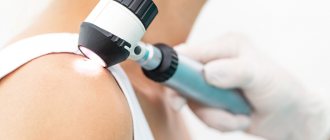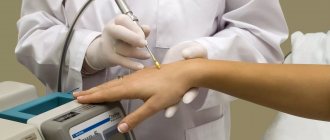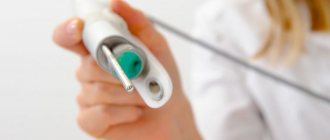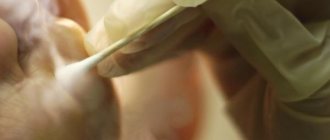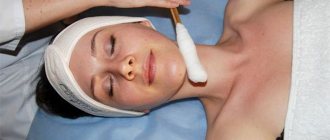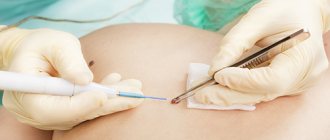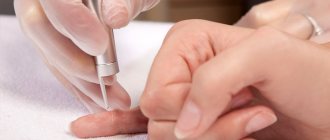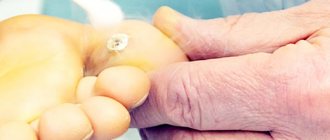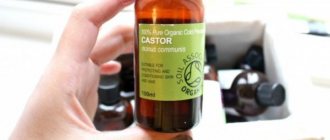The modern method of cryodestruction of papillomas allows you to eliminate formations using exposure to low-temperature substances, that is, freezing. This most often occurs when using liquid nitrogen, which can destroy the pathological papilloma tissue, but not damage the surrounding healthy skin. After the cryodestruction procedure, there is no bleeding, since liquid nitrogen blocks the arteries around the area of its effect. The cryodestruction sites heal very quickly and are not covered with scars.
What is a wart and what does it look like?
A wart is a benign neoplasm that appears on the epidermis as a result of damage to skin cells by the papilloma virus.
As a result of the destruction of healthy epidermal cells, the stratum corneum increases and a growth appears on the skin.
Most often, this type of formation is painless, but sometimes there are cases when, as a result of damage to the integrity of the surface of the growth, a person feels pain.
These types of formations can be located in absolutely any area of the body and come in various shapes and sizes.
Externally, warts look like a skin nodule that has a rough surface and most often differs in color from the natural shade of the skin.
Warts can be of the following types:
- Ordinary - formations that appear most often on the hands and do not give a person any unpleasant sensations;
- Plantar - formed on the soles of the feet, most often have painful symptoms and interfere with the normal process of walking. Visually similar to corns, however, more difficult to remove;
- Youthful - formations that practically do not exceed the level of the skin and differ slightly from the natural shade of the epidermis;
- Pointed - formations, most often appear in the axillary and groin area, are small nodules that, when fused together, form ridges.
Common wart Plantar wart Juvenile warts Pointed wart
A wart most often appears as a result of damage to the skin and untimely treatment with an antiseptic.
Warts also very often appear as a result of improper personal hygiene and visiting public places.
When should a wart be removed?
A wart can be removed at any time if it gives a person discomfort or interferes with work, but there are some situations in which wart removal is necessary.
Such situations include:
- Rapid increase in size;
- Pain and burning when pressed;
- Isolation of blood from the formation;
- Additional ones appeared at the site of formation;
- Warts that are present on the hands and lead to regular damage during work;
- On the foot when a wart prevents normal movement;
- Formation of warts on the genitals.
Before removing a wart, it is recommended to first undergo all tests and consult a doctor.
What studies can be prescribed for a patient with papillomas?
If a patient is diagnosed with papillomas, he is usually prescribed:
- Examination for the full range of sexually transmitted infections: syphilis and HIV, gonorrhea, trichomoniasis, chlamydia, genitourinary mycoplasmosis. This is necessary in the case of genital papillomas. To do this, the patient undergoes blood sampling from a vein and a smear examination for urogenital infections from the lower parts of the genitourinary tract (urethra, vagina, cervix).
- Blood test for sugar, cholesterol and lipid profile, bilirubin and transaminases. A clinical blood test can be offered to the patient to exclude those underlying diseases that served as a prerequisite for the presence of multiple papillomas on the skin or mucous membranes.
- Blood test for cryoglobulins - in case of suspected cryoglobulinemia before using the cryodestruction method.
Women with manifestations of genital HPV infection are prescribed a smear test for oncocytology and colposcopy - an examination of the condition of the cervical mucosa under a magnifying device (colposcope).
Removing warts with liquid nitrogen
The liquid nitrogen removal procedure or cryodestruction is aimed at performing the following tasks:
- Cells damaged by the virus are eliminated by freezing with liquid nitrogen;
- When applied correctly, the risk of burns is reduced to a minimal percentage;
- The possibility of reoccurrence of formation at the site of removal is eliminated;
- Thanks to this removal method, the duration of exposure to nitrogen does not take more than 30 seconds.
Using cold to remove warts allows you to quickly start the natural processes of cell regeneration.
Advantages and disadvantages of the method
| Advantages | Flaws |
| After removal there are practically no traces left | When removing deep-rooted warts, a slight burn may occur. |
| Nitrogen does not affect the condition of healthy skin fibers | Removal of large warts is carried out in several sessions |
| Nitrogen helps remove viral compounds, which reduces the likelihood of new growths forming | A formation that is removed cannot be studied |
| There is no bleeding during removal | Depending on the individual characteristics of the patient, swelling of the skin may be observed after the method. |
| No need to use anesthesia | |
| Removal is quick | |
| Small amount contraindication |
However, despite all the pros and cons of the procedure, this method of wart removal is very popular and is provided in almost all clinics.
What warts can be removed with liquid nitrogen?
Liquid nitrogen is used to remove the following types of warts:
- Plantar formations - a method used to remove warts on the feet and toes. To carry out this type of procedure, a special device is used, since in the area of the feet it is necessary to carry out a longer impact on the formation;
- Common warts - the procedure for removing this type of wart with nitrogen occurs quite quickly, and is used for the hands and feet. This type of procedure is very convenient, since these types of warts are rarely formed as a single specimen, much more often they are a cluster of formations, the removal of which can be carried out in several procedures;
- Senile - for such removal, nitrogen is applied manually and requires several applications. Also, when removing such warts, it is very important to take into account the size and number of formations on the body. Used for areas of the body such as arms, legs, face, back and abdomen;
- Flat - it is recommended to use nitrogen, since this type of procedure is considered the most gentle compared to other methods. Most often, the appearance of flat warts is accompanied by a large number, so several procedures are necessary to remove the formations. Used for all areas of the body except the breasts in women, the axillary and groin areas.
Each type of wart requires special treatment, so the duration of the procedure most often depends on the type of wart and the degree of neglect of the skin lesion by the virus.
What contraindications does the procedure have?
Like any type of procedure affecting the skin, removal of warts with nitrogen has the following types of contraindications:
- Swelling of the skin;
- Skin damage;
- Epileptic seizures;
- Oncological type education;
- Colds;
- Pregnancy;
- Children under 7 years of age;
- High blood pressure;
- Individual sensitivity to cold;
- The presence of inflammatory processes in the human body;
- Allergic reactions on the skin near the location of the infectious node.
If nitrogen removal is carried out in the presence of any contraindication, complications and aggravation of the disease may occur.
How to prepare for the procedure?
Before carrying out the procedure for removing warts with nitrogen, the following preparatory procedures must be carried out:
- Consult your doctor;
- Pass all necessary tests;
- Avoid taking any medications;
- Cleanse the skin of various cosmetics.
During the procedure, the patient must carefully monitor his health and, if it worsens, immediately notify the specialist.
Features of removing different types of warts with nitrogen
Depending on the type of wart, the following treatment features are observed:
- Flat warts are removed as follows: In a single case, nitrogen is applied to the growth with a cotton swab;
- For a large number of warts, cryomassage with nitrogen is used. To do this, nitrogen is applied to the cotton wool and the area where the formations accumulate is applied with quick circular movements;
- Most often, flat warts do not form a blister, but begin to peel off and disappear after a few weeks;
- Plantar warts are removed in several sessions, since most often such formations have deep-rooted roots;
The remaining species are removed in a classic manner and do not require special tools for applying nitrogen.
Recommendations for skin care after cryodestruction
After the procedure, the patient may need several weeks for tissue regeneration, so it is important to strictly follow the doctor’s instructions:
- During the first few days after the procedure, you should not use cosmetics. This restriction applies primarily to parts of the body that are susceptible to freezing.
- In the first three days after removal of papillomas, the treated areas should not be wetted.
- It is advisable to avoid direct sunlight on the nitrogen cauterization sites, wear closed clothing, gloves, a scarf, etc.
- Do not do the dressing yourself.
There is usually no urgent need for the use of potent drugs for wound healing during the recovery period. The only remedy that doctors recommend to accelerate tissue regeneration is “Hydrocortisone ointment.”
The need for a repeat procedure
The procedure is repeated in the following situations:
- For large warts, several sessions are recommended;
- If the root of the wart is located deep in the layers of the skin;
- When the crust fell off, the growth did not completely disappear;
- In cases where the boundaries of the wart remain with the presence of affected skin, it most often manifests itself in the form of inflammatory formations.
Most often, it turns out that only small formations can be eliminated at a time; all other types require several nitrogen exposure procedures.
What are the contraindications for cryodestruction of papillomas?
Cryodestruction is contraindicated if:
- 1. The presence of cold allergies - the appearance of itchy rashes and hives when exposed to cold.
- 2. Cryoglobulinemia is a syndrome that is accompanied by the appearance in the blood of cryoglobulins - specific proteins that form and precipitate at temperatures below 37°C. This syndrome manifests itself in the form of weakness, joint pain and the presence of a hemorrhagic rash. Accompanies conditions such as blood diseases, vasculitis - inflammation of blood vessels, Raynaud's syndrome, viral hepatitis C, etc.
- 3. Suspicion of the presence of a malignant process in the formations to be removed. In this case, a method should be chosen that will provide a full histological examination of the removed tissue in the laboratory.
- 4. The presence of urogenital infections with genital warts. In this case, it is more advisable to sanitize the identified infections before cryodestruction.
Is the procedure painful?
The degree of pain depends on the individual characteristics of the person, as well as on the size of the wart that will be treated with nitrogen. The sensation of touching nitrogen on the skin is similar to a cold metal object.
A person undergoing nitrogen cauterization may experience the following unpleasant sensations:
- Mild tingling sensation;
- Feeling of cold at the site of nitrogen exposure;
- Numbness of the area where the wart is located;
- A burning sensation at the site of nitrogen exposure most often occurs at the end of the procedure.
For children, it is recommended to use ointments with an analgesic effect; adults carry out such procedures only at their own discretion.
In some cases, discomfort may last for several days, depending on the size of the formation and the duration of exposure of the skin surface to nitrogen.
Indications
Cryodestruction is one of the most modern and effective procedures designed to remove condylomas, papillomas and moles.
When nitrogen acts on a growth, painful sensations occur in rare cases. With the help of cryodestruction, it is possible to get rid of various neoplasms on the surface of the skin, formed anywhere.
Cauterization with liquid nitrogen is prescribed in the following cases:
- The color, size, density or shape of the formation changes
- The cause of papilloma was hormonal therapy.
- Painful occur at the location of the growth.
- The neoplasm is subject to frequent injury.
- The papilloma grows, new growths appear along with the already formed ones.
Cryodestruction is also prescribed in the presence of inflammation and bleeding from papilloma. This causes not only moral discomfort, but also physical discomfort. It constantly hurts, and inflammation can cause infection or the formation of cancer cells.
Carrying out the procedure during pregnancy and childhood
Removing warts with nitrogen during pregnancy is not recommended, since any intervention in a woman’s body can further weaken the immune system and become a threat to the normal course of pregnancy.
However, if the formation quickly increases in size, then the procedure is performed.
In such cases, it is recommended to postpone the removal of warts with nitrogen until the second trimester.
Since in the first and third trimester, the woman and child are most susceptible to external stimuli. Nitrogen removal in childhood is used from 6-7 years .
However, if necessary, this procedure can be performed at an earlier age.
It is necessary to select a special approach for each child and build on the individual characteristics of the body.
Unlike adults, it is much more difficult for a child to tolerate this method of skin treatment.
Special drugs are used for pain relief and removal is carried out in several sessions.
Possible complications and consequences of the procedure
After a procedure using nitrogen, small spots or scars may remain on the human body.
However, there may be cases when other symptoms occur after removal:
- The appearance of peeling of the skin at the site of exposure to nitrogen most often occurs if large volumes of skin have been exposed to the substance. May appear after removal of juvenile warts;
- The appearance of a pigment spot at the site of exposure to the substance. However, this type of consequence of the procedure most often disappears after some time on its own;
- Scarring occurs most often if the dosage of nitrogen was calculated incorrectly, resulting in a burn.
Complications of this removal method can manifest themselves as follows:
- Formation of a blister that contains a large amount of serous fluid;
- Inflammatory process on the skin as a result of too deep exposure to nitrogen;
- Injuries to tissues located near the enlarged stratum corneum.
If the procedure is carried out in specialized institutions, the risk of complications is quite rare and the effect of nitrogen on the skin is well tolerated.
Removing warts at home
You can also burn off warts at home using cryotherapy. To do this, you just need to buy a special drug at the pharmacy, which is similar in effect to liquid nitrogen.
Such drugs include:
- Cryopharma - not liquid nitrogen is used as a refrigerant, but a specially created chemical compound. The disadvantage of this drug is the lack of a deep effect on the tissue, so it can only be used for superficial warts. The average price of the drug is from 500 rubles ;
- Wartner Cryo - the freezing temperature of this drug is about 60 °C, so the risk of side effects when using pharmaceuticals is small. The average price of the drug is from 700 rubles .
Cryopharma Wartner Cryo
You can use the products only after consulting a doctor, and strictly adhering to the instructions for use.
Contraindications for self-freezing warts are:
- Pregnancy and breastfeeding;
- Diabetes;
- Age up to 4 years;
- Growths on the mucous membranes.
Rehabilitation period
The wart does not fall off immediately. After exposure to liquid nitrogen, it becomes white and hard to the touch, turning white almost immediately. Since the cells inside it die, sensitivity is lost.
Two weeks after cryodestruction
The tumor disappears on the second day, and a scab forms in its place. It does not require special care. An antiseptic bandage can be applied over the inflamed and swollen skin. It is important to treat the scab with salicylic alcohol at a 2% concentration twice a day. If it is not available, use a solution of potassium permanganate. It is important to do this until the skin on the treated area begins to peel off.
Prevention of warts
A wart can appear in absolutely anyone, regardless of their lifestyle.
It is necessary to follow some general rules of prevention:
- Wash your hands after visiting public places, especially after using public transport;
- Promptly treat areas of skin damage with an antiseptic;
- Do not be in public places with high humidity without slippers;
- Do not use items that have been in contact with an infected person;
- Take an additional vitamin complex to improve immunity;
- Carefully monitor personal hygiene;
- Do not engage in casual sex;
- Eliminate bad habits;
- Do not use other people's things;
Following simple prevention rules helps reduce the risk of warts and other skin surface diseases.
